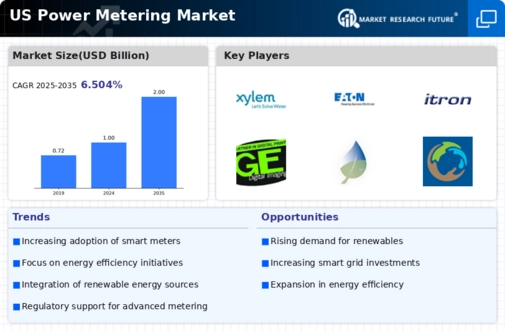The US Power Metering Market is characterized by a dynamic competitive landscape, driven by technological advancements and changing regulatory requirements. Various players in the market are striving to enhance their product portfolios to address the increasing demand for efficient energy management solutions, smart grid integration, and real-time data analytics. Competition is intensified by the integration of Internet of Things (IoT) capabilities into power metering solutions, enabling improved operational efficiency and customer engagement.
Amidst this environment, companies are focusing on strategic initiatives such as mergers and acquisitions, partnerships, and technological innovations to gain a competitive edge and adapt to market demands. The ongoing shift towards sustainable energy sources and smart infrastructure fosters opportunities for growth, making understanding the competitive insights essential for stakeholders in the US Power Metering Market.Sensus has established a significant presence in the US Power Metering Market, focusing on innovative solutions that cater to the needs of utilities and consumers alike.
The company is renowned for its advanced metering infrastructure (AMI) technologies, which enhance the efficiency and accuracy of energy consumption measurement. Sensus's strengths lie in its comprehensive product offerings such as smart meters and data analytics platforms, enabling utilities to optimize their operations and improve customer service. Its emphasis on customer-centric solutions drives Sensus to create tailored products that meet the specific requirements of different utility companies, resulting in strong customer loyalty and retention.
Additionally, the company's commitment to research and development empowers it to stay ahead of industry trends, ensuring that it can adapt quickly to emerging demands and regulatory changes within the US.Eaton is another key player in the US Power Metering Market, known for its wide array of energy management solutions and innovative power distribution equipment. The company's portfolio includes advanced metering technologies, power quality solutions, and energy monitoring systems, all designed to help utilities and businesses optimize their energy usage.
Eaton's strengths lie in its robust expertise in electrical engineering, solid reputation in reliability, and dedication to sustainability, positioning it as a trusted partner in energy management. The company has expanded its reach in the US market through strategic mergers and acquisitions, enhancing its technological capabilities and market presence substantially. Furthermore, Eaton's investments in smart technologies and digitalization facilitate the transition towards more efficient and sustainable power systems, keeping it competitive in a rapidly evolving marketplace.






















Leave a Comment